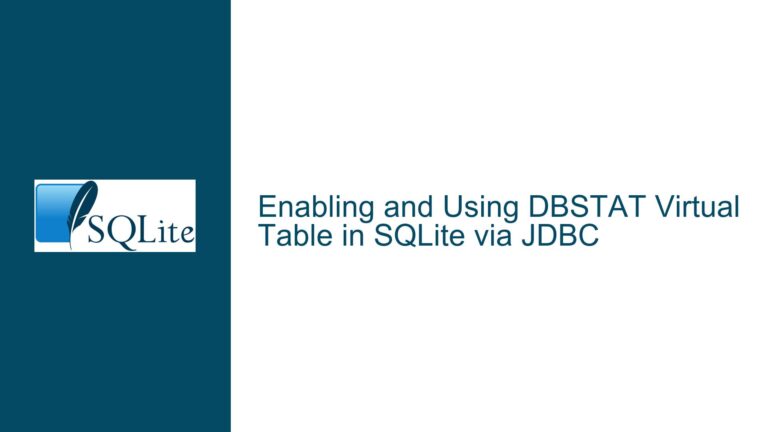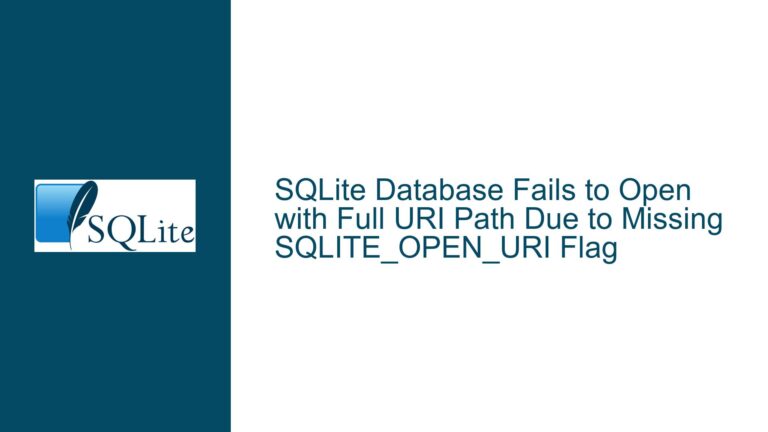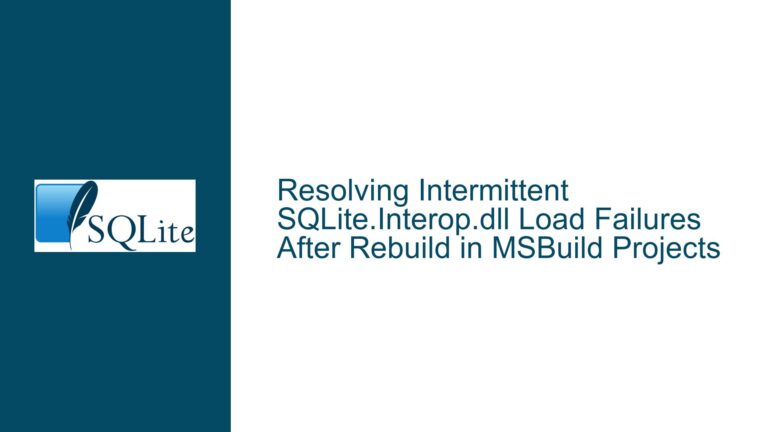SQLiteTransaction Behavior in System.Data.SQLite
SQLiteTransaction Attachment to SQLiteCommand: Implicit vs. Explicit Assignment
Issue Overview
The core issue revolves around whether a SQLiteTransaction object, created from a SQLiteConnection, is automatically attached to any SQLiteCommand executed within the scope of that connection. Specifically, the question arises from a colleague’s assertion that explicit assignment of the SQLiteTransaction object to the SQLiteCommand is unnecessary, as the transaction is implicitly attached to any command executed under the same connection. This assertion is based on the behavior observed in C/C++ libraries, where transactions are automatically managed without explicit assignment.
To understand this issue deeply, we must first explore the relationship between SQLiteConnection, SQLiteTransaction, and SQLiteCommand in the context of the System.Data.SQLite library. The SQLiteConnection object represents a connection to the SQLite database, while the SQLiteTransaction object represents a transaction that can be initiated on that connection. The SQLiteCommand object, on the other hand, represents a SQL statement or stored procedure that is executed against the database.
The crux of the issue lies in whether the SQLiteTransaction object needs to be explicitly assigned to the SQLiteCommand object, or if the transaction is automatically associated with any command executed under the same connection. This distinction is crucial because it affects how transactions are managed in an application, and incorrect assumptions can lead to unexpected behavior, such as commands being executed outside the intended transaction scope.
Possible Causes
Implicit Transaction Attachment in C/C++ Libraries: The colleague’s assertion may stem from the behavior observed in C/C++ libraries, where transactions are often implicitly managed. In these libraries, once a transaction is started on a connection, any subsequent commands executed on that connection are automatically included in the transaction. This behavior might lead to the assumption that the same applies to the System.Data.SQLite library.
Lack of Explicit Documentation: The System.Data.SQLite documentation may not explicitly state whether the
SQLiteTransactionobject needs to be assigned to theSQLiteCommandobject. This lack of clarity can lead to differing interpretations and assumptions about how transactions are managed.Inconsistent Behavior Across Different Libraries: Different libraries and programming languages may handle transactions differently. For example, some libraries may automatically attach transactions to commands, while others may require explicit assignment. This inconsistency can lead to confusion, especially when developers work with multiple libraries or migrate code between different environments.
Misinterpretation of the Source Code: The respondent in the discussion mentions that they cannot immediately prove that explicit assignment is unnecessary based on their reading of the source code. This suggests that the source code of the System.Data.SQLite library may not clearly indicate whether transactions are automatically attached to commands, leading to potential misinterpretation.
Potential Bugs or Edge Cases: There may be edge cases or bugs in the System.Data.SQLite library that cause transactions to behave differently than expected. For example, a bug might cause a command to be executed outside the intended transaction scope, even if the transaction is implicitly attached to the connection.
Troubleshooting Steps, Solutions & Fixes
Review the System.Data.SQLite Documentation: The first step in resolving this issue is to thoroughly review the official documentation for the System.Data.SQLite library. Look for any mention of how transactions are managed, particularly whether the
SQLiteTransactionobject needs to be explicitly assigned to theSQLiteCommandobject. If the documentation is unclear or lacks sufficient detail, consider reaching out to the library’s maintainers or community for clarification.Examine the Source Code: If the documentation does not provide a clear answer, the next step is to examine the source code of the System.Data.SQLite library. Look for the implementation of the
SQLiteConnection,SQLiteTransaction, andSQLiteCommandclasses, and trace how transactions are associated with commands. Pay particular attention to any methods or properties that might indicate whether transactions are automatically attached to commands.Conduct Empirical Testing: To determine whether transactions are automatically attached to commands, conduct empirical testing. Create a test scenario where a
SQLiteTransactionobject is created from aSQLiteConnection, and then execute multipleSQLiteCommandobjects without explicitly assigning the transaction. Use logging or debugging to verify whether the commands are executed within the transaction scope. Repeat the test with explicit assignment of the transaction to the commands and compare the results.Compare Behavior with C/C++ Libraries: If the colleague’s assertion is based on behavior observed in C/C++ libraries, compare the behavior of the System.Data.SQLite library with that of the C/C++ libraries. Look for any differences in how transactions are managed, and consider whether these differences might explain the colleague’s assertion. If the behavior is indeed different, document these differences and use them to inform best practices for using the System.Data.SQLite library.
Implement Explicit Transaction Assignment: Regardless of whether transactions are automatically attached to commands, it is generally a good practice to explicitly assign the
SQLiteTransactionobject to theSQLiteCommandobject. This ensures that the command is executed within the intended transaction scope and avoids any potential ambiguity or unexpected behavior. Update the codebase to include explicit assignment of transactions to commands, and document this practice for future reference.Handle Edge Cases and Potential Bugs: If empirical testing or source code examination reveals any edge cases or potential bugs related to transaction management, implement appropriate safeguards. For example, if a bug causes commands to be executed outside the intended transaction scope, consider adding additional checks or validation to ensure that commands are executed within the correct transaction. If necessary, report any bugs to the maintainers of the System.Data.SQLite library and monitor for updates or fixes.
Educate the Team: Once the issue has been resolved, educate the development team on the findings and best practices for managing transactions in the System.Data.SQLite library. Provide clear guidelines on when and how to explicitly assign transactions to commands, and explain the rationale behind these practices. This will help prevent similar issues from arising in the future and ensure that the team is aligned on how to manage transactions effectively.
Monitor for Updates: The behavior of the System.Data.SQLite library may change over time as new versions are released. Monitor the library’s release notes and documentation for any updates related to transaction management, and update the codebase and practices accordingly. Stay engaged with the library’s community to stay informed about any changes or best practices that may affect how transactions are managed.
Consider Alternative Libraries: If the System.Data.SQLite library’s transaction management behavior is found to be inconsistent or problematic, consider evaluating alternative libraries that provide more predictable or well-documented transaction management. When evaluating alternative libraries, consider factors such as performance, ease of use, and community support, and ensure that the chosen library aligns with the application’s requirements and development practices.
Document the Findings: Finally, document the findings and resolution of this issue in a way that is accessible to the entire development team. Include details on the problem, the steps taken to investigate and resolve it, and the best practices for managing transactions in the System.Data.SQLite library. This documentation will serve as a valuable resource for future reference and help ensure that the team is equipped to handle similar issues in the future.
In conclusion, the issue of whether a SQLiteTransaction object needs to be explicitly assigned to a SQLiteCommand object in the System.Data.SQLite library is a nuanced one that requires careful investigation. By reviewing the documentation, examining the source code, conducting empirical testing, and implementing best practices, developers can ensure that transactions are managed effectively and that commands are executed within the intended transaction scope. Educating the team and documenting the findings will further reinforce these practices and help prevent similar issues from arising in the future.






